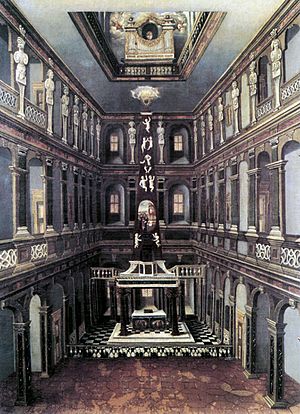Ärgre dich, o Seele, nicht, BWV 186 facts for kids
Quick facts for kids Ärgre dich, o Seele, nicht |
|
|---|---|
| Church cantata | |

The Schlosskirche in Weimar
|
|
| Occasion |
|
| Performed | |
| Movements | eleven in two parts; originally six |
| Vocal | SATB choir and solo |
| Instrumental |
|
Ärgre dich, o Seele, nicht (which means "Do not be confounded, o soul") is a special kind of church music called a cantata. It was written by the famous composer Johann Sebastian Bach. This piece is also known as BWV 186.
Bach first wrote this cantata in 1716 in a German city called Weimar. It was for a church holiday called Advent. This first version is known as BWV 186a. Later, in 1723, Bach made it longer and performed it in Leipzig. This new version was for the seventh Sunday after Trinity, and it was first played on July 11, 1723.
Contents
How the Cantata Was Created
The First Version in Weimar
Bach wrote the first version of this cantata in 1716. It was meant for the third Sunday of Advent. During this time, churches would read specific Bible stories. For this Sunday, they read about John the Baptist from the Gospel of Matthew.
The words for the cantata were written by a poet named Salomo Franck. He published his lyrics in a book in 1717. Bach used these words for his music. The original cantata, BWV 186a, had six parts.
- Chorus: Ärgre dich, o Seele, nicht
- Aria 1: Bist du, der da kommen soll
- Aria 2: Messias läßt sicjh merken
- Aria 3: Die Armen will der Herr umarmen
- Aria 4: Laß Seele, kein Leiden
- Chorale: Darum, ob ich schon dulde
Bach performed this first version in Weimar on December 13, 1716.
Making It Longer in Leipzig
In Leipzig, there was a rule called tempus clausum (meaning "closed time"). This rule meant that certain types of music, like cantatas, could not be performed during Advent. So, Bach couldn't use his Advent cantata there.
Instead, he decided to make it longer for a different church holiday: the seventh Sunday after Trinity. He added new parts called recitatives. He also changed some of the words in the arias (songs for one singer).
Bach replaced the original ending hymn (called a chorale) with a different one. This new chorale was "Es ist das Heil uns kommen her" by Paul Speratus. He even added another verse from this chorale to end the first half of the cantata.
The Bible readings for the new Sunday were about "the gift of God is eternal life" from the Epistle to the Romans. They also included the story of Jesus feeding 4,000 people from the Gospel of Mark. The new parts Bach added to the cantata mentioned words like "hunger" to connect with these stories.
What Instruments and Voices Are Used?
This cantata is performed by four solo singers: a soprano, an alto, a tenor, and a bass. There is also a four-part choir.
The instruments include two oboes, a taille (which is like a tenor oboe), a bassoon, two violins, a viola, and a basso continuo. The basso continuo is a group of instruments that play the bass line and harmonies, like a cello and a harpsichord.
The cantata has eleven different parts, called movements. It is divided into two main sections. The first six movements are performed before the church sermon. The remaining five movements are performed after the sermon.
- Chorus: Ärgre dich, o Seele, nicht
- Recitative (bass): Die Knechtsgestalt, die Not, der Mangel
- Aria (bass): Bist du, der mir helfen soll
- Recitative (tenor): Ach, daß ein Christ so sehr
- Aria (tenor): Mein Heiland läßt sich merken
- Chorale: Ob sichs anließ, als wollt er nicht
-
- After the sermon:
- Recitative (tenor): Es ist die Welt die große Wüstenei
- Aria (soprano): Die Armen will der Herr umarmen
- Recitative (alto): Nun mag die Welt mit ihrer Lust vergehen
- Aria (soprano, alto): Laß, Seele, kein Leiden
- Chorale: Die Hoffnung wart' der rechten Zeit
The Music of the Cantata
The very first part of the cantata, the opening chorus, has a repeating musical pattern. It's like a musical sandwich, where a main idea (A) keeps coming back with different ideas (B) in between.
The four arias (songs for solo singers) become more complex as the cantata goes on. They also move from lower voices to higher ones. The first aria is simple, with just a bass singer and the continuo instruments. The next two arias use three instruments. The last aria is a duet for two singers (soprano and alto) with the full orchestra. This final aria sounds a bit like a lively dance. The singers often move their voices together, showing the meaning of the words "My soul, let no sorrow separate you from Jesus."
The recitatives are parts where the singers "speak" the words in a musical way, almost like talking. All four of them end with a short, more song-like section called an arioso.
The two chorale movements (numbers 6 and 11) are the same music. They are like a special kind of hymn arrangement called a chorale fantasia. The main hymn tune is played by the orchestra. The soprano singer sings the main tune, while the other singers add faster, more complex parts around it.
Where to Hear It
Many groups have recorded this cantata. You can find recordings by famous conductors and choirs. Some of these include Helmuth Rilling, Nikolaus Harnoncourt, Ton Koopman, Masaaki Suzuki, Pieter Jan Leusink, and John Eliot Gardiner.
See also
In Spanish: Ärgre dich, o Seele, nicht, BWV 186 para niños


